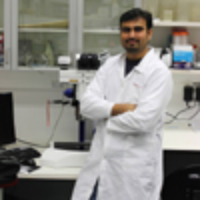The importance of gestational age in first trimester, maternal urine MALDI-Tof MS screening tests for Down Syndrome
Published on: 31st December, 2019
OCLC Number/Unique Identifier: 8513004205
Background: The proposal that MALDI-ToF mass spectrometry could be used as a direct, rapid and affordable diagnostic tool in clinical laboratory medicine has moved from a theoretical possibility to a reality for Microbiology. Several studies have proposed the application of this technology in obstetric and gynaecological evaluation of patients. In particular, we have proposed that the adoption of MALDI-ToF mass spectrometry in examination of maternal pregnancy urine samples for the detection of Downs syndrome.
Methods: A retrospective collection of 20 Down Syndrome and 100 non-aneuploid pregnancy urines at 12 to 14 weeks gestation, collected in 2007-2008 from high risk pregnancy cohorts, were examined by MALDI-ToF mass spectrometry in the mass/charge range between 1000 and 100000 m/z. Normalisation of spectral data was defined using mass bins of 100 m/z expressed as a percentage of the total ion count of the mass spectra from 2000 to 11000 m/z. Of the ninety 100 m/z bins, forty-six were identified as m/z bins at which statistically significant differences in spectra occurred between Downs and control/non-aneuploid samples. Based on the differences and variance, for values at these bins, weighted scores of the probability of being Downs were assigned. Comparative algorithms consisting of various mass bins were tested for ability to distinguish Down syndrome from non-aneuploid pregnancy.
Results: Although various algorithms could distinguish Downs from non-aneuploid controls, it was found that gestational age was a confounding factor and that if separated into gestational age matched cohorts the ability to distinguish the groups improved dramatically e.g. whilst a 19 bins algorithm separated 100% of Downs from non-aneuploid pregnancies for a 9% false positive rate in the mixed gestational ages group; a two bin algorithm distinguished 100% of Downs for a 6% false positive rate for the 12 weeks gestational age pregnancies.
Conclusion: Normalised MALDI-ToF mass spectra, at 2000 to 11000 m/z, of maternal urine gives rise to gestational age specific screening tests algorithms for Downs’s syndrome.
Needs in siblings of individuals with Down Syndrome and levels of coping Cali, Colombia
Published on: 1st November, 2021
OCLC Number/Unique Identifier: 9323541686
Objective: To determine the needs and level of coping in siblings of people with Down Syndrome. Methods: Descriptive, cross-sectional study, carried out in 2016. Sample consisted of 30 siblings of people with Down Syndrome between 6 and 60 years old. Using non-probability convenience sampling. Two instruments were used to collect the information: a) a validated sociodemographic and needs survey of the siblings, designed by the authors, and b). Callista Roy adaptation and coping survey validated. Results: 60% of the siblings report not having felt judged by other people when presenting their brother/sister with Down syndrome. 73.3% of the siblings did not receive information about Down Syndrome from a nursing professional, the need to strengthen the nursing care provided to the siblings of people with disabilities in this regard is evident. 53.3% of these present a medium level of coping with respect to the condition of having a brother with Down syndrome. Conclusion: Identified needs were: time needs, affective needs, family needs, social needs, economic and access to information needs. Highlighting these needs allows the nursing professional to identify and consider the siblings of people with Down Syndrome have different needs than the rest of the family nucleus. Where interventions aimed at reducing the harmful effects and enhancing those characteristics of gain related with having a brother with Down Syndrome.
Amniotic Fluid Ischemia Modified Albumin as a Novel Prenatal Diagnostic Marker for Down Syndrome: A Prospective Case-Control Study
Published on: 21st June, 2023
Aims: There is no study in the literature about ischemia-modified albumin (IMA) and hepatocyte growth factor (HGF) levels in amniotic fluid for Down syndrome cases. The aim of this study was to investigate the changes of IMA and HGF in Down syndrome cases at 16-20 weeks of gestation compared to normal fetuses.Methods: For this prospective case-control study, following reaching the number of 20 women (study group) who had the prenatal diagnosis of Down syndrome, maternal and gestational age-matched pregnant women with normal constitutional karyotype were selected for the control group (n = 74) from the stored amniotic fluid samples. Results: Mean women and gestational ages were comparable between the two groups. Amniotic fluid IMA (1.32 ± 0.13 vs. 1.11 ± 0.11 ABSU, respectively, p < 0.001) and HGF (2743.53 ± 1389.28 vs. 2160.12 ± 654.63 pg/mL, respectively, p = 0.008). Levels were significantly higher in pregnant women having Down syndrome fetuses compared with women having normal fetuses. The amniotic fluid IMA levels for the diagnosis of Down syndrome, and the sensitivity and specificity were calculated as 95.0% and 71.6% for the limit value 1.171 cm3, respectively. Conclusion: In cases with suspected Down syndrome, the diagnosis of Down Syndrome may be made in approximately 1 hour with high sensitivity and specificity by measuring the IMA level in the amniotic fluid sample taken for fetal karyotyping.
Challenges and Concerns of Parents with Children with Down Syndrome
Published on: 18th July, 2023
Down syndrome is a common chromosomal abnormality that affects individuals in their physical, cognitive, and social development. The diagnosis of this syndrome in a newborn can be challenging for parents as it may disrupt family dynamics. In this study, we describe the different aspects of the impact of Down syndrome on parents, including psychological, social, and familial impacts. 55 cases participated in this survey; the average age of parents was 34 years old, and mothers represented 96% of the participants. 70% of cases were from urban areas. The average time between diagnosis and parental evaluation was 32.7 months. In 57% of families, the diagnosis of Down syndrome was established only after the third month of pregnancy, and only 5% obtained it during the prenatal period. Depression was reported in 32% of mothers at the time of diagnosis, while one mother exhibited persistent denial of her child’s disability. 30% of families indicated that their child with Down syndrome was the source of tension within the couple and that learning difficulties were the main factor of tension, while 1% eventually divorced. 5% of parents regretted having a child with Down syndrome. All mothers expressed concerns about their child’s future and are in favor of the establishment of a national screening program for trisomy 21 and dedicated learning centers to ensure social and professional integration.




